Nei moderni progetti di illuminazione, la flessibilità è diventata importante tanto quanto la luminosità o l'efficienza. Designer, ingegneri e appaltatori non sono più soddisfatti del semplice controllo on/off: hanno bisogno di un'illuminazione che si adatti a diversi stati d'animo, funzioni e obiettivi energetici. È qui che le luci a strisce LED dimmerabili svolgono un ruolo cruciale. Tuttavia, con più protocolli di dimming disponibili, dalle opzioni analogiche di base ai sistemi digitali avanzati, la scelta della soluzione giusta può creare confusione. In questo articolo, esploreremo le migliori opzioni di strip light dimmerabili, confronteremo i loro punti di forza e di debolezza e forniremo una guida pratica su come selezionare il metodo di dimmerazione più adatto per il tuo progetto.
Perché l'attenuazione è importante nell'illuminazione a strisce LED
L'illuminazione non è più solo fornire una luminosità sufficiente per vedere. Sia nei progetti commerciali che residenziali, si prevede di creare comfort, risparmiare energia e adattarsi a diversi compiti. Le luci a LED dimmerabili offrono ai progettisti e ai proprietari di edifici la possibilità di mettere a punto l'illuminazione piuttosto che accontentarsi di un approccio unico.
Dal punto di vista energetico, l'oscuramento riduce direttamente il consumo energetico. Quando le luci vengono abbassate a 50%, il consumo di energia in genere diminuisce di una quantità simile, il che si traduce in bollette inferiori e un'impronta ambientale inferiore. Per le aziende che gestiscono grandi spazi, questa efficienza può aumentare i significativi risparmi a lungo termine.
Il comfort e l'atmosfera sono un altro motivo importante. Un negozio al dettaglio potrebbe desiderare una luce più brillante durante le ore di punta per evidenziare i prodotti, mentre una lounge dell'hotel potrebbe preferire un bagliore più caldo e morbido la sera. Le strisce dimmerabili consentono a un sistema di soddisfare entrambe le esigenze senza cambiare i dispositivi.
C'è anche la questione della durata. I LED in funzione a potenza ridotta generano meno calore, che possono prolungare la durata sia della striscia che della sua alimentazione. Per i Facility Manager, ciò significa meno sostituzioni e minori costi di manutenzione.
Infine, il dimming consente l'integrazione con i sistemi di controllo intelligenti. Gli uffici possono automatizzare i livelli di luce in base alla luce del giorno e i luoghi di intrattenimento possono sincronizzare le strisce con gli effetti musicali o teatrali. Questo livello di controllo è diventato standard nel design moderno dell'illuminazione e le strisce LED dimmerabili lo rendono accessibile in un formato flessibile e compatto.

Riepilogo dei metodi di regolazione della striscia LED
Quando si tratta di luci a LED dimmerabili, non esiste un'unica soluzione "universale". Sono stati sviluppati diversi protocolli di attenuazione per soddisfare le esigenze di varie applicazioni, che vanno da semplici ristrutturazioni di case a progetti commerciali su larga scala e luoghi di intrattenimento. Ogni metodo ha i suoi vantaggi, limitazioni e requisiti tecnici.
Prima di immergerti nei dettagli di come funziona ogni sistema, è utile fare un passo indietro e guardare il quadro più ampio. La tabella seguente fornisce un confronto affiancato delle opzioni di dimmerazione più comuni - PWM, TRIAC, 0-10V, DALI e DMX - in modo da poter vedere rapidamente come si differenziano in termini di definizione, punti di forza, inconvenienti e applicazioni tipiche.
| Metodo di oscuramento | Definizione | Pro | Contro | Applicazioni tipiche |
| PWM (modulazione larghezza impulso) | Regola la luminosità accendendo/spegnendo rapidamente i LED e variando il ciclo di lavoro. | Ampia gamma di dimmerazione, conveniente, semplice da implementare. | Può introdurre sfarfallio se mal progettato, limitato per reti di grandi dimensioni. | Residenziale, Retail, Illuminazione Generale. |
| Triac (dimming a taglio di fase) | Utilizza la tecnologia di taglio di fase CA, richiede un driver LED compatibile. | Funziona con dimmer a parete tradizionali, facile retrofit. | Problemi di compatibilità, meno precisi, rischio di sfarfallio. | Aggiornamenti domestici, piccoli progetti. |
| 0-10 V dimmer | Controllo analogico utilizzando un segnale 0–10V per regolare la luminosità. | Affidabile, ampiamente adottato in contesti commerciali. | Ha bisogno di un cablaggio di controllo aggiuntivo; funzionalità avanzate limitate. | Uffici, scuole, ospedali, fabbriche. |
| DALI (interfaccia di illuminazione digitale indirizzabile) | Protocollo digitale con comunicazione bidirezionale e indirizzabilità. | Intelligente, flessibile, consente il raggruppamento e il controllo individuale. | Costo più elevato, richiede la messa in servizio. | Alberghi, uffici di fascia alta, edifici intelligenti. |
| DMX (Multiplex digitale) | Protocollo digitale progettato per l'illuminazione da palcoscenico, supporta effetti RGB. | Alta precisione, ideale per strisce LED che cambiano colore. | Cablaggio complesso, richiede una configurazione qualificata. | Teatri, club, intrattenimento, illuminazione di facciate. |
Con questa panoramica in mente, ora possiamo dare un'occhiata più da vicino a ogni metodo di attenuazione, esplorando come funziona nella pratica, cosa lo rende unico e dove si adatta meglio ai progetti del mondo reale.
Dimming PWM (modulazione larghezza impulso)
Definizione
PWM, o modulazione della larghezza di impulso, è uno dei modi più comuni per controllare la luminosità delle luci a strisce a LED. Invece di abbassare la tensione ai LED, PWM funziona accendendo e spegnendo rapidamente la luce ad una frequenza molto elevata. Modificando il rapporto tra il tempo di attivazione e il tempo di disattivazione (noto come duty cycle), l'emissione luminosa media appare più luminosa o più debole all'occhio umano.
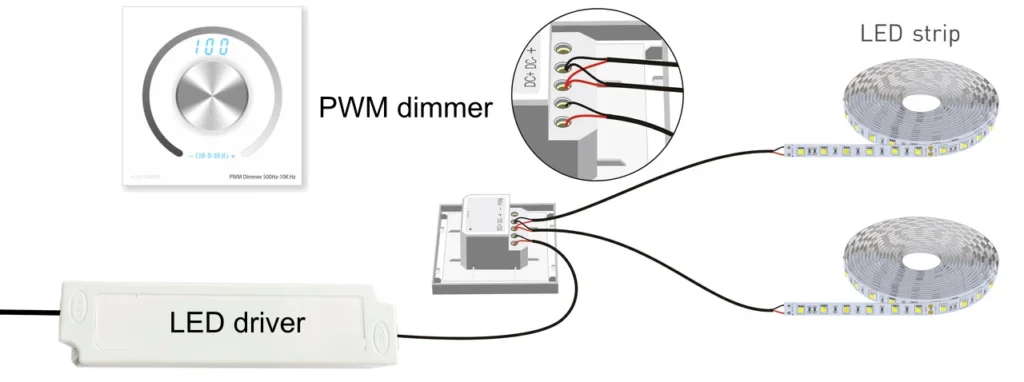
Caratteristiche
Una delle caratteristiche chiave di PWM è la sua ampia gamma di dimmerazione. I LED possono essere regolati senza problemi dalla luminosità completa fino a livelli molto bassi senza spostamento del colore significativo, rendendolo un'opzione versatile per molti progetti.
Un'altra caratteristica è la compatibilità. Il dimming PWM è supportato da un'ampia varietà di driver e controller LED, dai semplici telecomandi portatili ai sistemi smart home avanzati. Questo lo rende un facile punto di ingresso sia per gli utenti residenziali che per le piccole installazioni commerciali.
Anche l'efficacia in termini di costi è una caratteristica importante. Rispetto ai protocolli digitali più avanzati, i sistemi di dimmerazione PWM sono relativamente convenienti e richiedono apparecchiature meno specializzate.
Pro e contro
Il principale vantaggio di PWM è la sua flessibilità. Offre una qualità della luce costante su diversi livelli di luminosità e può essere utilizzata in strisce LED monocolore, bianco sintonizzabili e RGB. Il suo costo inferiore lo rende anche una scelta pratica per progetti con budget limitati.
Sul lato negativo, i sistemi PWM mal progettati possono introdurre sfarfallio visibile, specialmente a livelli di dimming molto bassi o registrati dalle telecamere. Sebbene il PWM ad alta frequenza possa ridurre questo effetto, richiede un'attenta progettazione del driver e del sistema di controllo. PWM è anche meno adatto per reti molto su larga scala, dove i protocolli di comunicazione analogici o digitali forniscono una maggiore stabilità.
Applicazioni
L'abbassamento PWM è ampiamente utilizzato nell'illuminazione residenziale, come strisce sotto il mobile, illuminazione d'accento o installazioni decorative. Negli ambienti di vendita al dettaglio, può fornire una regolazione flessibile della luminosità per evidenziare i prodotti in diversi momenti della giornata. Anche i progetti commerciali più piccoli, come caffè o boutique, beneficiano della sua convenienza e facilità d'uso.

Dimmerazione TRIAC
Definizione
Il dimming TRIAC, noto anche come dimming a taglio di fase, è un metodo originariamente progettato per lampade a incandescenza e alogene. Funziona tagliando una parte della forma d'onda CA prima di raggiungere la sorgente luminosa, riducendo efficacemente la quantità di potenza erogata. Quando applicato all'illuminazione a strisce LED, è necessario un driver AC/DC compatibile per tradurre questo segnale in un'alimentazione CC stabile per i LED.
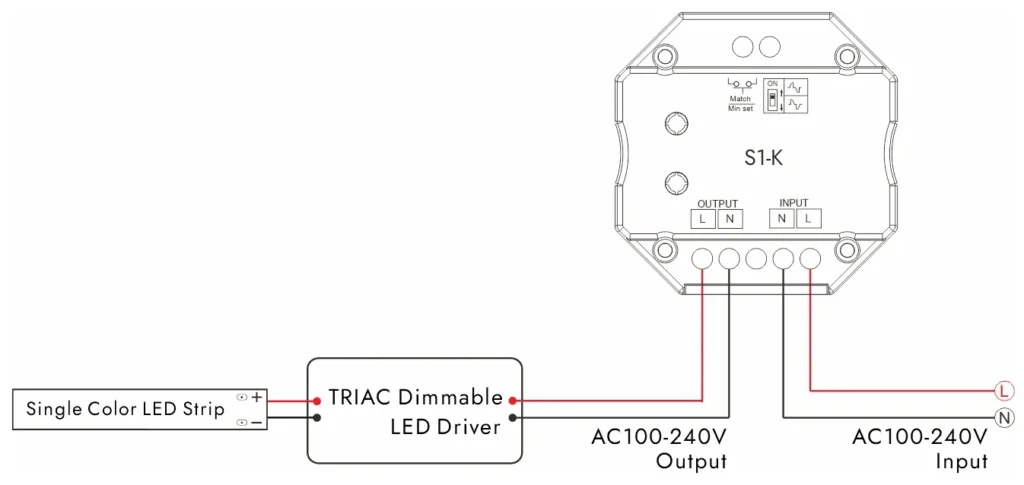
Caratteristiche
La caratteristica più notevole del triac è la sua compatibilità con i tradizionali dimmer a parete. Questo lo rende una soluzione interessante per i progetti di retrofit, in cui sono già presenti cablaggi e interruttori esistenti. Gli utenti possono spesso mantenere i loro vecchi interruttori dimmer durante l'aggiornamento alla tecnologia LED.
Un'altra caratteristica importante è la sua semplicità. Poiché funziona direttamente con l'ingresso CA, il dimming TRIAC non richiede un cablaggio di controllo aggiuntivo. Per i proprietari di case o gli installatori che cercano un aggiornamento diretto, ciò può far risparmiare tempo e costi durante l'installazione.
Infine, il dimming triac è ampiamente disponibile. Poiché è stato utilizzato per decenni nel settore dell'illuminazione, i driver e i dimmer compatibili con Triac sono facili da reperire nella maggior parte dei mercati.
Pro e contro
Il vantaggio chiave dell'attenuazione del triac è la comodità. Permette una transizione graduale dalle vecchie tecnologie di illuminazione ai LED senza la necessità di ricablare completamente un sistema. È anche relativamente conveniente rispetto ai protocolli di controllo digitale.
D'altra parte, il dimming triac può presentare problemi di compatibilità. Non tutti i driver LED rispondono bene ai segnali di taglio di fase, che possono causare sfarfallio, portata di regolazione limitata o rumore di ronzio. La sua precisione è anche inferiore a protocolli come DALI o 0-10V, il che lo rende meno adatto a progetti che richiedono un controllo fine.
Applicazioni
L'attenuazione del triac è più comunemente utilizzata nell'illuminazione residenziale, in particolare nei progetti di ristrutturazione in cui i proprietari di case desiderano strisce LED dimmerabili senza modificare le proprie infrastrutture elettriche. È adatto anche a piccoli spazi commerciali, caffè o ristoranti che preferiscono un tradizionale dimmer a parete per il controllo di base dell'illuminazione.

0-10 V dimmer
Definizione
Il dimming 0-10V è uno dei metodi più antichi e più ampiamente adottati per controllare l'illuminazione a LED in ambienti commerciali. Utilizza un segnale a bassa tensione, tipicamente tra 0 e 10 volt, per regolare la luminosità. A 10 V la striscia LED funziona a piena luminosità, mentre a 0V la luce è al suo livello minimo o completamente spenta, a seconda del design del driver.
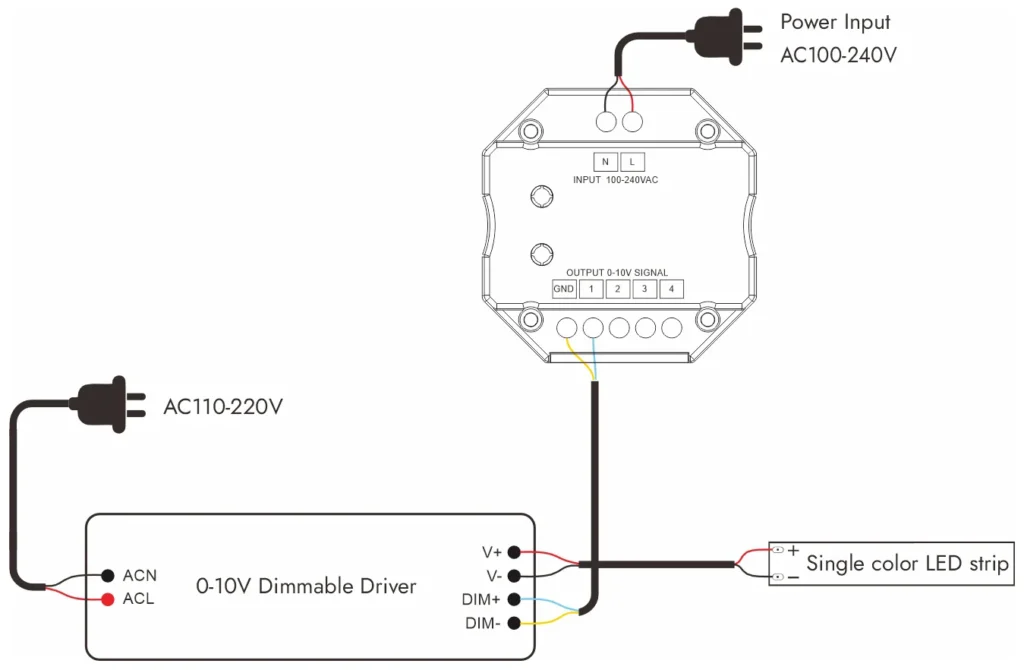
Caratteristiche
Una delle caratteristiche principali dell'oscuramento 0-10V è la sua affidabilità. Poiché si tratta di un sistema analogico, il segnale di controllo è diretto e non soggetto a errori di comunicazione digitale. Questo lo rende una soluzione affidabile per le prestazioni a lungo termine in ambienti difficili.
Un'altra caratteristica è la scalabilità 0 I sistemi a 10 V sono relativamente facili da espandere, consentendo di controllare più driver LED con lo stesso segnale. Ciò è particolarmente utile in stanze grandi o spazi aperti dove sono richiesti livelli di illuminazione coerenti in molti infissi.
Tuttavia, il sistema richiede una coppia di fili aggiuntiva per il segnale di controllo, oltre al cablaggio di alimentazione principale. Sebbene questa sia una piccola considerazione nelle nuove costruzioni, può aggiungere complessità negli scenari di retrofit.
Pro e contro
I principali vantaggi dell'oscuramento 0-10V sono stabilità, semplicità e ampia accettazione del settore. È una tecnologia collaudata che funziona bene con le strisce LED e può integrarsi con i sensori di occupazione e i sistemi di raccolta della luce del giorno negli edifici commerciali.
Sul lato negativo, 0-10V è limitato nelle sue capacità di controllo rispetto a protocolli digitali come DALI. Ogni gruppo di apparecchi collegati agli stessi fili di controllo si attenuerà insieme, rendendo impossibile il controllo individuale o indirizzabile. La necessità di cablaggi aggiuntivi lo rende anche meno attraente per i piccoli progetti residenziali.
Applicazioni
L'oscuramento 0-10V è molto popolare in uffici, scuole, ospedali ed edifici industriali, dove l'illuminazione coerente e affidabile è una priorità. Viene spesso utilizzato nell'illuminazione a soffitto combinata con strisce LED per attività o illuminazione ambientale. In questi contesti, offre il giusto equilibrio tra l'accessibilità economica e il controllo di livello professionale.
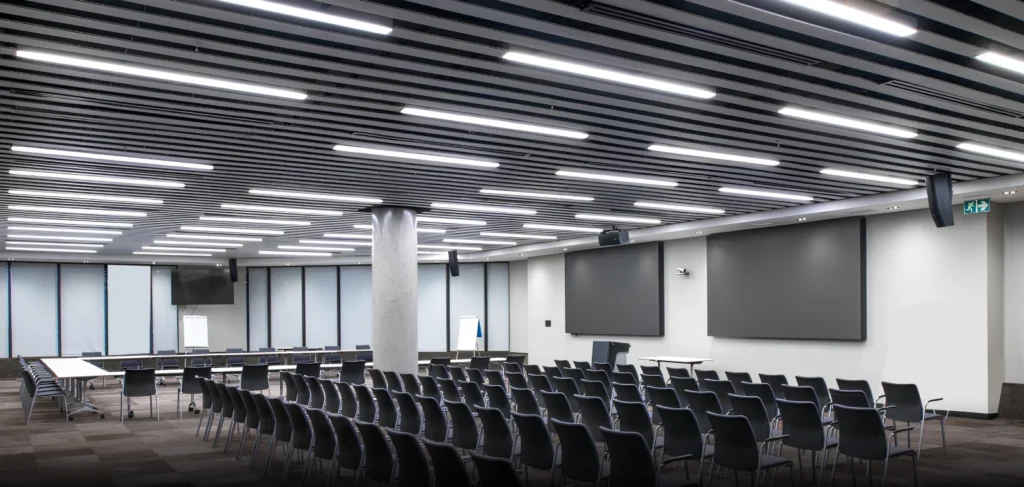
DALI Dimming (interfaccia di illuminazione digitale indirizzabile)
Definizione
DALI, abbreviazione di Digital Responsible Lighting Interface, è un protocollo digitale standardizzato appositamente sviluppato per il controllo dell'illuminazione. A differenza dei metodi analogici, DALI consente la comunicazione bidirezionale tra i dispositivi e il sistema di controllo. Ogni driver o controller collegato a una rete DALI può essere indirizzato individualmente, consentendo un controllo preciso e flessibile su grandi gruppi di strisce LED e altri dispositivi.
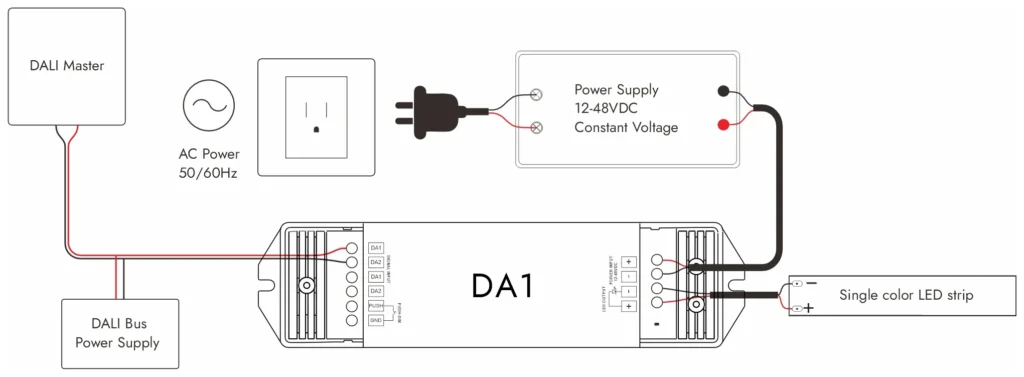
Caratteristiche
La caratteristica più importante di DALI è l'indirizzabilità. Ogni dispositivo sul bus DALI può essere programmato per funzionare in modo indipendente o come parte di un gruppo. Ciò offre ai progettisti del luminoso una maggiore libertà nel modo in cui gli spazi vengono illuminati e regolati nel tempo.
Un'altra caratteristica è l'integrazione. DALI è spesso utilizzato in edifici intelligenti in cui l'illuminazione deve funzionare perfettamente con i sistemi di gestione degli edifici (BMS). Supporta la pianificazione, la raccolta della luce diurna e il controllo basato sull'occupazione, rendendolo una scelta pronta per il futuro.
Dali offre anche comunicazione bidirezionale. Gli apparecchi possono inviare feedback al sistema di controllo, come stato, consumo di energia o informazioni sugli errori. Ciò aggiunge valore per i facility manager che necessitano di un monitoraggio continuo di grandi installazioni.
Pro e contro
I vantaggi chiave di DALI sono flessibilità, precisione e scalabilità. Consente l'impostazione avanzata della scena e può essere riprogrammata facilmente senza ricablaggio maggiore. Per i progetti di fascia alta, questo livello di controllo può giustificare l'investimento.
Gli svantaggi riguardano principalmente il costo e la complessità. I driver DALI e le apparecchiature di controllo sono più costosi delle soluzioni più semplici e l'installazione richiede un'adeguata messa in servizio da parte di personale qualificato. Per i piccoli progetti, la spesa aggiuntiva può superare i benefici.
Applicazioni
Il dimming DALI è ampiamente utilizzato in progetti commerciali premium come hotel, torri per uffici, musei e campus intelligenti. In questi ambienti, l'illuminazione non è solo funzionale ma anche parte dell'esperienza utente complessiva e della strategia di efficienza degli edifici. Le luci a LED controllate da DALI possono essere integrate perfettamente in soffitti, pareti o mobili, fornendo sia l'estetica che il controllo intelligente.

Dimming DMX (multiplex digitale)
Definizione
DMX, abbreviazione di Digital Multiplex, è un protocollo di controllo originariamente sviluppato per l'illuminazione teatrale e teatrale. Da allora è diventato uno standard nell'illuminazione dell'intrattenimento e dell'architettura in cui gli effetti dinamici e la precisione sono essenziali. Nell'illuminazione a strisce LED, DMX è particolarmente apprezzato per le applicazioni RGB e RGBW, dove i singoli canali devono essere controllati per una miscelazione del colore regolare e sequenze complesse.
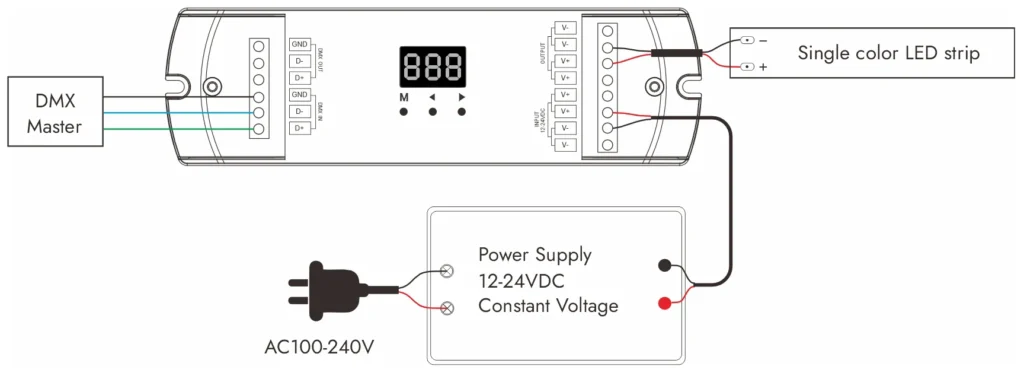
Caratteristiche
Una delle caratteristiche distintive di DMX è la precisione. Il protocollo fornisce 256 livelli di controllo per canale, che si traduce in un'attenuazione regolare e variazioni di colore accurate. Per i progetti che si basano su effetti di luce drammatici, questo livello di dettaglio è fondamentale.
Un'altra caratteristica è la versatilità. Un singolo controller DMX può gestire centinaia di canali, consentendo ai progettisti di creare un'illuminazione sincronizzata su grandi facciate, palchi o spazi per eventi. Ogni striscia LED o driver può essere assegnata a indirizzi specifici, consentendo di creare disegni altamente personalizzati.
DMX supporta anche la programmazione dinamica. Con software speciali o console di controllo, le scene di illuminazione possono essere preimpostate e attivate in tempo reale, spesso sincronizzate con musica, video o esibizioni dal vivo.
Pro e contro
Il più grande vantaggio di DMX è il suo potenziale creativo. Apre la porta a effetti infiniti, dalle dissolvenze fluide a stroboscopi, inseguimenti o spettacoli di colori a spettro completo. Per luoghi di intrattenimento o progetti architettonici che vogliono distinguersi, DMX offre possibilità impareggiabili.
Il lato negativo è la complessità. DMX richiede un'attenta pianificazione, cablaggio dedicato e configurazione professionale. Sebbene potente, è eccessivo per semplici applicazioni di strisce LED bianche o progetti su piccola scala. Il sistema richiede anche competenze continue, poiché i controllori e il software devono essere programmati correttamente.
Applicazioni
DMX Dimming è la scelta di riferimento per teatri, club, parchi a tema ed eventi dal vivo in cui il controllo dinamico è essenziale. È anche sempre più utilizzato nell'illuminazione architettonica, come facciate edilizie, ponti e punti di riferimento pubblici, dove gli effetti colorati migliorano l'identità visiva. Per l'illuminazione a strisce LED, il DMX viene spesso scelto per progetti RGB/RGBW che richiedono effetti vibranti e programmabili.

Come scegliere l'opzione di dimmerazione giusta per il tuo progetto
Quando si tratta di selezionare un metodo di dimmerazione per l'illuminazione a strisce LED, non esiste una soluzione "taglia unica". La scelta giusta dipende dalla scala del tuo progetto, dal budget, dalla compatibilità del sistema e dagli obiettivi di progettazione. Di seguito una guida pratica per aiutarti a decidere:
1. Per illuminazione di base commerciale o per ufficio – 0-10V
Se il tuo progetto è relativamente semplice, senza bisogno di una programmazione avanzata, il dimming 0-10V offre una scelta economica e affidabile. È particolarmente adatto per uffici, magazzini e aree commerciali generiche in cui è sufficiente un attenuazione regolare.
2 . Per progetti di costruzione intelligente – DALI
Quando il tuo progetto richiede controllo centralizzato, impostazione della scena e scalabilità futura, DALI è la soluzione professionale. Si integra perfettamente con i sistemi di gestione degli edifici (BMS) e si adatta a grandi uffici, ospedali, scuole e spazi commerciali di fascia alta.
3. Per illuminazione residenziale e decorativa – TRIAC
Se desideri la compatibilità con i dimmer a parete esistenti, in particolare nelle case, nei ristoranti o al dettaglio, il dimming triac è la scelta più conveniente. Evita il cablaggio extra e funziona bene con atmosfere di illuminazione calde e accoglienti.
4. Per progetti che richiedono un controllo regolare a livello di apparecchio – PWM
Il dimming PWM è ideale per strisce LED dove la luminosità e la consistenza del colore precise sono importanti. È ampiamente utilizzato nell'illuminazione decorativa, nell'illuminazione d'accento e nei progetti in cui sono necessarie prestazioni senza sfarfallio.
5. Per progetti di intrattenimento e architettura – DMX
Quando hai bisogno di effetti dinamici, cambi di colore vibranti o illuminazione sincronizzata con musica o video, DMX è il chiaro vincitore. È più adatto per teatri, club, punti di riferimento o grandi facciate in cui l'impatto visivo è fondamentale.
Pensieri finali
Scegliere il giusto protocollo di dimmerazione significa bilanciare semplicità e flessibilità. I progetti su piccola scala beneficiano di soluzioni semplici come 0-10V o TRIAC, mentre i sistemi grandi e complessi spesso richiedono DALI o DMX. Per le applicazioni in cui la qualità della luce è fondamentale, PWM rimane una scelta affidabile.

In SignLiteled, forniamo una gamma completa di strisce LED dimmerabili e driver compatibili, lavorando con marchi affidabili come Tridonic, Euchips, Sunricher e Lifud. Che tu abbia bisogno di una configurazione di base o di un sistema di illuminazione intelligente professionale, il nostro team può aiutarti a trovare la soluzione migliore.
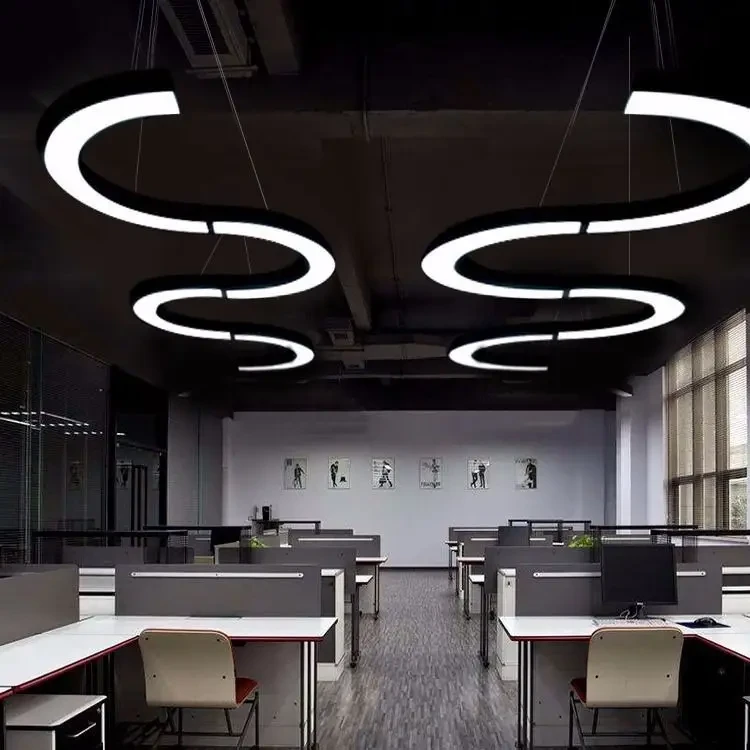
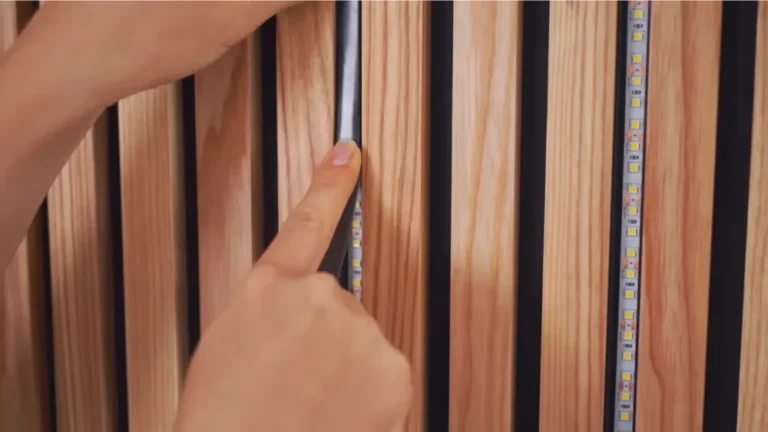
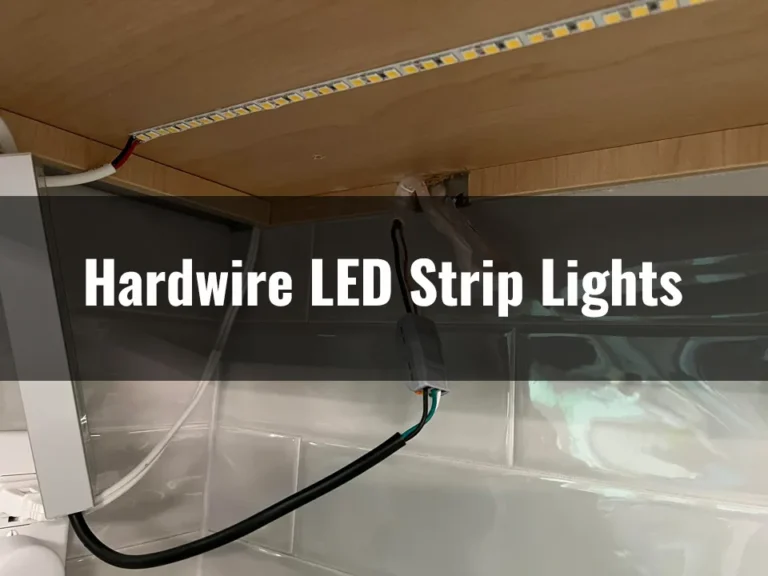


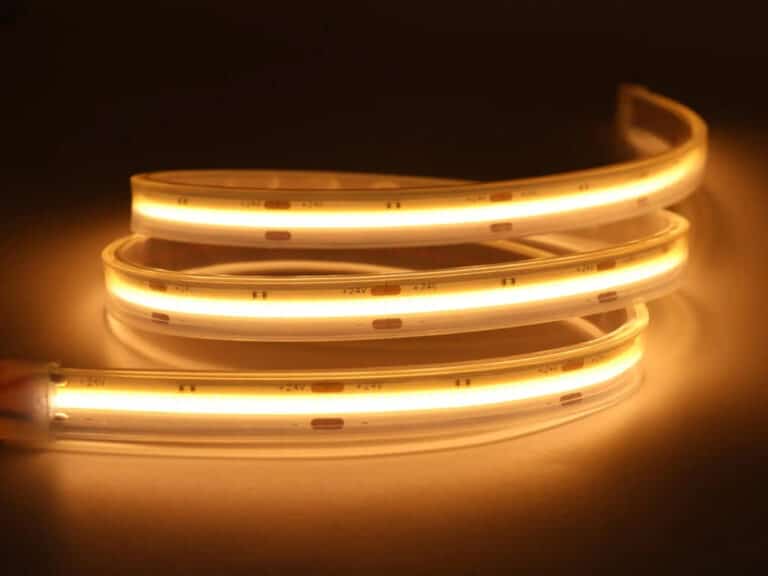

mio fratello ha suggerito che mi sarebbe piaciuto questo sito web, aveva perfettamente ragione, questo post ha effettivamente reso la mia giornata non puoi immaginare quanto tempo avevo speso per queste informazioni grazie
Meraviglioso sito web Molte informazioni utili qui lo mando ad alcuni amici e ne condivido anche deliziosa e ovviamente grazie al tuo sforzo